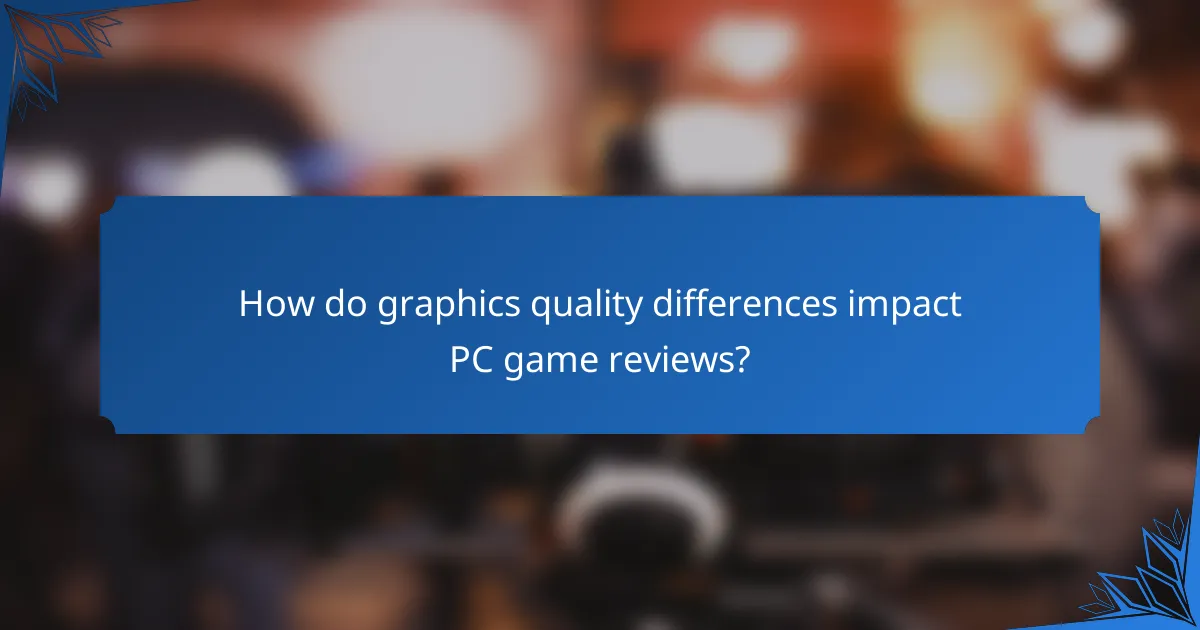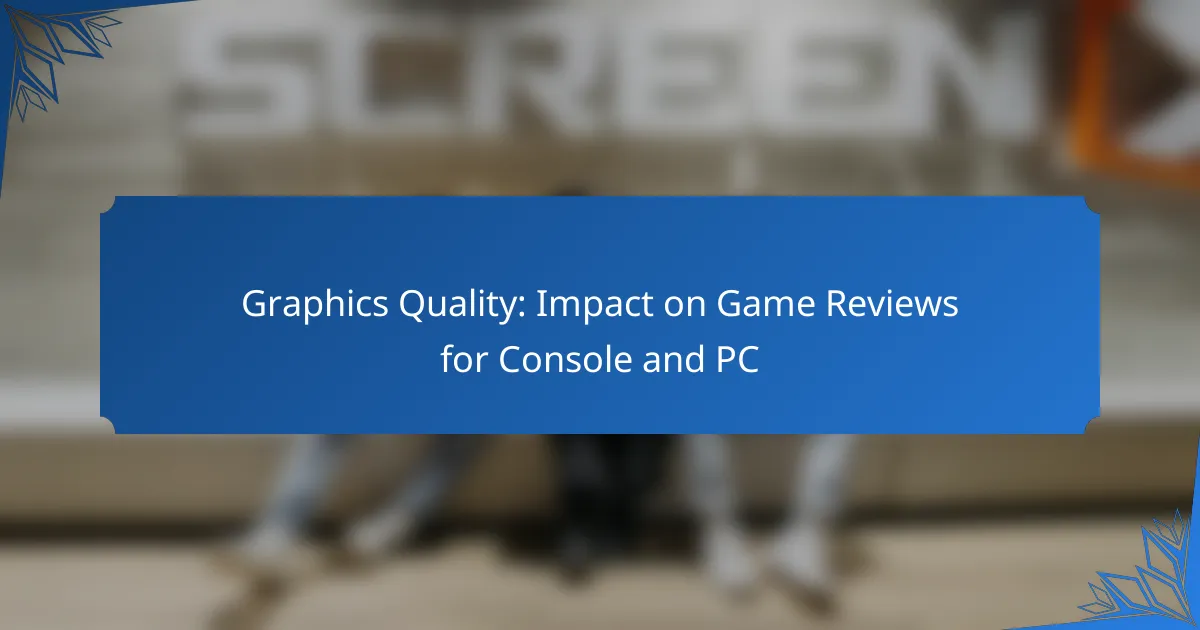Graphics quality is a pivotal element in determining game reviews for both consoles and PCs, as it directly impacts player enjoyment and immersion. Factors such as resolution, frame rate, and texture detail not only enhance the visual experience but also play a significant role in shaping player opinions and critic scores.

How does graphics quality affect game reviews for consoles?
Graphics quality plays a crucial role in shaping game reviews for consoles, as it directly influences players’ enjoyment and immersion. Higher graphics quality often leads to better reviews, as it enhances the overall gaming experience and meets player expectations.
Higher resolution enhances visual fidelity
Higher resolution in games significantly improves visual fidelity, making images sharper and more detailed. For consoles, resolutions like 1080p or 4K are commonly expected, with many players preferring the latter for its clarity. Reviews often highlight resolution as a key factor, as it can elevate the aesthetic appeal of a game.
When assessing a game’s graphics, reviewers may compare resolutions across platforms, noting how a game performs on a console versus a high-end PC. This comparison can impact the overall score, as players often seek the best visual experience available.
Frame rate stability improves gameplay experience
Frame rate stability is essential for a smooth gameplay experience, particularly in fast-paced genres like action and racing games. A stable frame rate, ideally around 60 frames per second (fps) or higher, ensures fluid motion and responsive controls, which are critical for player satisfaction.
In reviews, games that maintain a consistent frame rate tend to receive higher ratings. Conversely, games that suffer from frame drops or stuttering can frustrate players, leading to lower scores. Developers should prioritize optimizing frame rates to enhance the overall reception of their titles.
Texture quality impacts immersion
Texture quality significantly impacts immersion by adding depth and realism to game environments. High-resolution textures can make surfaces appear more lifelike, enhancing the player’s connection to the game world. Reviewers often assess texture quality, noting how it contributes to the overall aesthetic and feel of the game.
For consoles, texture quality can vary based on hardware capabilities. Games that utilize advanced texture techniques, such as anisotropic filtering, often receive praise for their visual richness. Developers should focus on delivering high-quality textures to create a more engaging experience for players, which can positively influence reviews.

What are the key graphics attributes influencing reviews?
The key graphics attributes that influence game reviews include resolution, frame rate, and texture detail. These factors significantly affect the overall visual experience and can sway player opinions and critic scores.
Resolution (4K vs. 1080p)
Resolution refers to the number of pixels displayed on the screen, with 4K offering four times the pixel count of 1080p. Higher resolutions like 4K provide sharper images and more detail, which can enhance immersion in a game.
However, not all players have access to 4K displays, and performance can vary based on the hardware. Gamers should consider their own setup and preferences when evaluating the importance of resolution in reviews.
Frame rate (60 FPS vs. 30 FPS)
Frame rate, measured in frames per second (FPS), indicates how smoothly a game runs. A frame rate of 60 FPS is generally preferred for a smoother experience, especially in fast-paced games, while 30 FPS may suffice for slower-paced titles.
Higher frame rates can lead to improved responsiveness and reduced motion blur, which are critical for competitive gaming. Players should check if their console or PC can consistently achieve the desired frame rate before prioritizing it in their gaming experience.
Texture detail and rendering techniques
Texture detail refers to the quality of the surfaces in a game, while rendering techniques encompass how these textures are displayed. High-quality textures can make environments and characters look more realistic, enhancing the overall visual appeal.
Advanced rendering techniques, such as ray tracing, can create more dynamic lighting and shadows, further improving realism. However, these features often require powerful hardware, so players should balance visual fidelity with performance capabilities when assessing game reviews.

How do graphics quality differences impact PC game reviews?
Graphics quality significantly influences PC game reviews by affecting visual fidelity, performance, and overall player experience. Higher graphics settings can enhance immersion and enjoyment, leading to better review scores, while lower settings may detract from the game’s appeal.
PC hardware capabilities allow for higher settings
PC gaming hardware varies widely, enabling players to adjust graphics settings based on their system’s capabilities. High-end graphics cards and processors can support ultra settings, resulting in sharper textures, improved lighting, and smoother frame rates. Reviewers often assess how well a game utilizes available hardware to deliver an optimal visual experience.
For instance, a game that runs smoothly at 60 FPS on high settings with a GeForce RTX 3080 is likely to receive higher praise than one that struggles on lower-end hardware. This capability to push graphics limits is a key factor in reviews, as it showcases the game’s technical achievements.
Graphics card performance affects review scores
The performance of a graphics card plays a crucial role in determining how well a game performs under various settings. Reviewers often benchmark games on different graphics cards to evaluate frame rates, resolution, and visual quality. A game that runs well on a range of cards, from budget to high-end, tends to receive favorable scores.
For example, if a game maintains playable frame rates on both mid-range and high-end graphics cards, it demonstrates good optimization, which is a positive aspect in reviews. Conversely, poor performance on widely used cards can lead to lower scores, as it limits accessibility for many players.
Customization options enhance player experience
Customization options in graphics settings allow players to tailor their experience based on personal preferences and hardware capabilities. Games that offer a variety of settings, such as texture quality, shadow detail, and anti-aliasing, enable players to find a balance between performance and visual fidelity.
Reviewers often highlight how these options contribute to player satisfaction. For instance, a game that allows players to adjust settings for competitive play, such as lowering visual effects for better visibility, can be viewed more favorably. Providing players with the ability to optimize their experience is a significant factor in overall game reviews.

What are the graphics quality benchmarks for major consoles?
The graphics quality benchmarks for major consoles focus on resolution, frame rates, and graphical fidelity. These factors significantly influence game performance and player experience, impacting overall game reviews.
PlayStation 5 graphics capabilities
The PlayStation 5 (PS5) boasts impressive graphics capabilities, supporting 4K resolution at up to 120 frames per second (fps) with ray tracing. This allows for highly detailed environments and realistic lighting effects, enhancing immersion in games.
Developers can take advantage of the PS5’s custom SSD, which reduces load times and allows for more complex game worlds. Titles like “Demon’s Souls” and “Ratchet & Clank: Rift Apart” showcase these advanced graphics features effectively.
Xbox Series X performance metrics
The Xbox Series X matches the PS5 in graphics performance, also supporting 4K resolution and up to 120 fps with ray tracing capabilities. Its powerful hardware enables smooth gameplay and high-quality visuals, making it a strong competitor in the console market.
With features like Smart Delivery, players can access the best version of a game for their console, ensuring optimal graphics performance. Games such as “Halo Infinite” and “Forza Horizon 5” highlight the Series X’s graphical prowess.
Nintendo Switch graphics limitations
The Nintendo Switch has more modest graphics capabilities compared to the PS5 and Xbox Series X, typically running games at 720p in handheld mode and 1080p docked. While it may not match the graphical fidelity of its competitors, it offers unique gameplay experiences.
Despite these limitations, titles like “The Legend of Zelda: Breath of the Wild” and “Super Mario Odyssey” demonstrate that engaging gameplay can outweigh graphical constraints. Developers often focus on art style and gameplay mechanics to create enjoyable experiences on the Switch.

How do graphics quality trends evolve in gaming?
Graphics quality trends in gaming evolve through advancements in technology, impacting both visual fidelity and gameplay experience. As hardware capabilities increase, developers leverage new techniques to enhance realism and immersion, influencing player expectations and game reviews.
Emergence of ray tracing technology
Ray tracing technology simulates the way light interacts with objects, producing highly realistic lighting, shadows, and reflections. This technique has become increasingly accessible with modern graphics cards, allowing games to achieve cinematic quality visuals.
Many recent titles, such as “Cyberpunk 2077” and “Control,” have integrated ray tracing, significantly enhancing their graphical appeal. However, this technology demands substantial processing power, often requiring players to balance performance settings to maintain smooth gameplay.
Impact of AI on graphics rendering
Artificial intelligence (AI) is revolutionizing graphics rendering by automating processes like texture generation and upscaling. Techniques such as NVIDIA’s DLSS (Deep Learning Super Sampling) enable games to render at lower resolutions while maintaining high-quality visuals, improving frame rates without sacrificing detail.
AI-driven enhancements can lead to more efficient use of hardware resources, allowing even mid-range systems to deliver impressive graphics. However, players should be aware that reliance on AI can sometimes introduce artifacts or inconsistencies in visual quality.
Future of graphics in VR gaming
The future of graphics in virtual reality (VR) gaming is focused on achieving higher fidelity and immersion. As VR headsets become more advanced, developers are exploring techniques like foveated rendering, which prioritizes detail in the player’s line of sight while reducing the load on peripheral areas.
With the increasing demand for realistic environments, VR games are expected to leverage ray tracing and AI technologies to create lifelike experiences. Players should consider the importance of hardware compatibility and performance optimization to fully enjoy these advancements in VR gaming.

What are the implications of graphics quality on player engagement?
Graphics quality significantly impacts player engagement by influencing the overall experience and immersion in a game. High-quality visuals can enhance enjoyment and retention, leading to a more dedicated player base.
High-quality graphics attract more players
Games with high-quality graphics often draw in more players due to their visual appeal. Stunning visuals can create a sense of realism and immersion that captivates gamers, making them more likely to invest time and money into the experience.
For example, titles that utilize advanced rendering techniques, such as ray tracing, can create lifelike environments that enhance gameplay. This can lead to higher sales and a larger community around the game, as players share their experiences and visuals on social media platforms.
However, developers must balance graphics quality with performance. While high-end graphics can attract players, they may also require powerful hardware, which could limit the audience. Offering scalable graphics settings can help accommodate a wider range of players, ensuring that both casual and hardcore gamers can enjoy the game.



